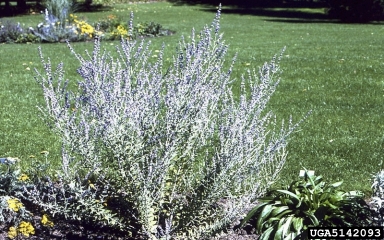Summer begins in June. That can mean much hotter, dryer conditions, but many of our plants thrive in these conditions. One such plant that tolerates drought and loves the heat is Russian Sage.
Russian Sage, Perovskia atriplicifolia, is a suffrutescent plant which means it is a woody plant whose top is not hardy to Nebraska so it acts like an herbaceous plant and dies back to the woody base every year. Because of this , it is best to cut it back to within several inches of the woody base in early spring before new growth begins. It will grow up to 4 feet tall and wide. It has opposite, gray-green leaves that are dissected to have a feathery appearance. The flowers are violet-blue and held in many long, 9 to 12-inch panicles, or spikes, throughout the plant. Blooming begins in June and last until August or September. Russian sage is a member of the mint family, having an aromatic scent, sometimes described as a sage scent.
There are many great varieties of Russian Sage to choose from. ‘Little Spire’ is a compact variety, growing to only 2 feet tall. ‘Longin’ is a more upright form that will grow more formal than the straight species which grows tall and tends to flop over. ‘Filigran’ is a selection from Germany that has more dissected foliage which gives the plant a lacy appearance. ‘Blue Haze’ has paler blue flowers with leaves that are not finely cut. ‘Blue Spire’ grows to 3 feet tall and has larger, deep purple flowers.
Russian Sage can be grown as a specimen plant or as a group of many in a landscape bed. They are tough plants that grow in most locations, including the “hell strip” of a landscape bed where it gets very hot and dry. It will also tolerate part sun but can become leggy and fall over in shade, especially if it is kept too wet. This is a plant that does not transplant well, especially older plants, but it can be propagated as softwood cuttings that are transplanted around the landscape.
Russian Sage is a great addition to any acreage landscape as bees and other insects love it. It was the 1995 Perennial Plant Associations Perennial Plant of the Year. Russian Sage is not a true sage, so it should not be eaten or used in cooking.
Russian Sage is a great plant for many locations throughout the landscape. It pairs well with asters, daisies, and lilies and the purple color of Russian Sage combines with the yellow of black-eyed Susan. It will grow in the tough, hot locations of your landscape and fill in a large space fairly quickly. Because it is a suffrutescent, it is best to prune it back to the base in early spring before new growth begins to avoid damage from winter freezing and thawing if fall pruned. So the next time you look for a new shrub for your landscape, look at Russian Sage, it isn’t a true shrub, but it will grow large and bloom throughout the majority of the summer months.

